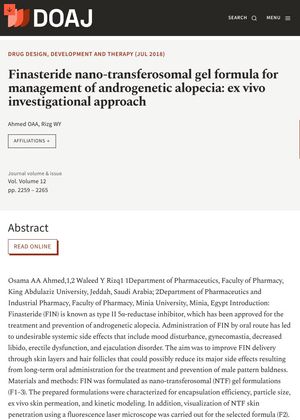Finasteride Nano-Transferosomal Gel Formula for Management of Androgenetic Alopecia: Ex Vivo Investigational Approach
July 2018
in “
DOAJ (DOAJ: Directory of Open Access Journals)
”

TLDR The new gel formula could improve the delivery of a hair loss treatment through the skin and might be an alternative to taking it by mouth.
In 2018, researchers Osama AA Ahmed and Waleed Y Rizq developed a nano-transferosomal (NTF) gel formula of Finasteride (FIN), a type II 5α-reductase inhibitor used for treating and preventing androgenetic alopecia. The aim was to improve FIN delivery through skin layers and hair follicles to potentially reduce major side effects from long-term oral administration, such as mood disturbance, gynecomastia, decreased libido, erectile dysfunction, and ejaculation disorder. Three formulations (F1-3) were prepared and characterized for encapsulation efficiency, particle size, ex vivo skin permeation, and kinetic modeling. The encapsulation efficiency percentage was 69.72 ± 8.36, 89.43 ± 6.82, and 93.1 ± 1.93 for F1, F2, and F3, respectively. The average vesicle sizes were 299.6 ± 45.6, 171 ± 25.6, and 197.4 ± 29.1 nm for F1, F2, and F3, respectively. All three formulations showed improved FIN permeation compared to raw FIN gel formula. The NTF formula showed uniform fluorescence intensity across rat skin, indicating improved delivery through skin layers. The study concluded that the NTF gel formula could enhance FIN delivery across skin layers and could be an alternative to oral therapy.

